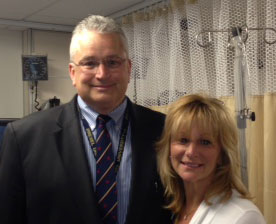Couple Kym and Owen Montgomery Improve Student Learning and Women’s Health with Transdisciplinary Education
May 1, 2013
 Kymberlee Montgomery, '09, opened her DrNP dissertation with an epitaph: “Be the change you wish to see in the world.” Her husband Owen Montgomery, MD’s motivation stems from a similar world view. “Thomas Jefferson has a quote about responsibility,” Owen said. “If you have the ability to change the world for the better, you also have the responsibility to change it.” Kym and Owen Montgomery are living their personal missions, effecting major changes at Drexel University and beyond as academicians, clinicians and educators. They have championed interdisciplinary education, bringing students and faculty from the Colleges of Nursing and Health Professions and Medicine together online, in the classroom, and in clinical simulations.
Kymberlee Montgomery, '09, opened her DrNP dissertation with an epitaph: “Be the change you wish to see in the world.” Her husband Owen Montgomery, MD’s motivation stems from a similar world view. “Thomas Jefferson has a quote about responsibility,” Owen said. “If you have the ability to change the world for the better, you also have the responsibility to change it.” Kym and Owen Montgomery are living their personal missions, effecting major changes at Drexel University and beyond as academicians, clinicians and educators. They have championed interdisciplinary education, bringing students and faculty from the Colleges of Nursing and Health Professions and Medicine together online, in the classroom, and in clinical simulations.
Drexel degrees are a common denominator in the Montgomery family. Kym graduated from the College of Nursing and Health Professions’ DrNP program in 2009. Owen finished medical school at Hahnemann University (now Drexel) in 1981. Their six children are all either current Drexel students or recent alumni. “They watched me get an amazing education [at Drexel]. The doctoral program here is top-notch,” Kym said. Both of Owen’s parents worked at the University; his father was a professor of psychiatry at Hahnemann and his mother was Chair of Humanities and Communications and then worked as Vice President for Program Evaluation. Kym’s mother currently works in billing within Drexel’s Department of OBGYN. “It’s like it’s in our family DNA,” Owen said.
Kym and Owen met 25 years ago on the floor at Jefferson in Labor and Delivery and they later married in 2000. “Most of our professional life has overlapped, and pleasantly,” Kym began. “When we came to Drexel, we worked collaboratively and have always provided great support for each other’s work. We started doing lectures for each other- I for his students at the medical school and he for my nursing students. We started building on what we thought was a successful model of taking our strengths from both disciplines so that students could learn together.” Kym and Owen found that this approach fostered communication between students in different disciplines and they have been working to expand and improve the transdisciplinary education model ever since.
The Nurse Practitioner programs in which Kym teaches have set class times even though the courses are in an online format. “It’s rigorous and I think ideal for students searching for more. It’s a viable option that’s just as much if not more rigorous than an in-person program,” she began. Kym went on to say that it is often easier to connect with students on a more personal level in the online format.
Owen said that today’s students prefer to watch lectures online rather than go to physical classrooms. “The modern student is teaching us that sitting in class is not the way they want to learn,” he said. One reason he cites for this phenomenon is that students have individualized preferences for the time of day or night they work the best.
Both Kym and Owen agree that the online format will help facilitate more global education. Owen has co-developed a cesarean section high fidelity simulator prototype with his colleagues named C-Celia, with the objective of using the manikin to teach health professionals around the world about C-section best practices. His ultimate goal is to reduce maternal and newborn mortality, especially in countries where there are not enough trained professionals who can perform C-sections safely. C-Celia was used during a cesarean section simulation at the Interprofessional Simulation Day on the College of Nursing and Health Professions’ campus on April 30, an event that Kym and Owen view as their biggest collaborative success. They run the event four times every year, bringing students from the Physician Assistant, Nurse Practitioner, Nurse Anesthesia, and undergraduate nursing programs as well as medical students and OBGYN residents into the same room together to solve problems and respond to cases that mimic real-life interprofessional environments, from hospital rooms to makeshift triage stations in other countries. The new Drexel University Partnership in Interprofessional Education (DUPIE) is under Kym’s leadership and additionally includes ER and Anesthesia residents.
“My goal is to truly educate collaboratively,” Kym said. “The best outcomes for the patient in a perfect world happen when all disciplines come together for the highest quality care. Practicing clinically and being an educator gives me the most satisfaction working toward that goal. To practice well together, we need to learn together.”
“Every day, in everything that I’m doing, I have the opportunity to teach someone else how to do what somebody once taught me,” Owen ended.